Seating Issues: Kyphosis, Sliding, Inadequate Support, Skin Redness
 Ben had suffered multiple problems in his old chair, most noticeably, he had little to no head support and a fixed kyphotic posture, resulting in it being difficult for him to lift his head or extend his neck.
Ben had suffered multiple problems in his old chair, most noticeably, he had little to no head support and a fixed kyphotic posture, resulting in it being difficult for him to lift his head or extend his neck.
Another problematic issue for Ben was that his field of vision was restricted due to the curvature of the neck and upper spine. He was often facing downward. The position of his head and neck caused issues breathing and eating, making his risk of choking & aspiration high.
Ben would slide from his chair at regular intervals throughout the day, causing him to develop red areas on his sacrum. In doing so, this would place an increased need for his caregivers to constantly reposition him.
Other significant postural issues included a pelvic obliquity, imbalanced weight distribution, pelvic rotation to the right, as well as a leg length discrepancy. These issues added were compounded due to the issues in his spine.
Intervention: Fully Supportive Tilt in Space Chair
After being assessed, it was recommended that Ben be placed in a Phoenix chair to improve his postural alignment, as well as possibly helping prevent further kyphotic deterioration.
 Upon being seated in the chair, the adjustable laterals, along with the head and shoulder supports, proved helpful in supporting Ben’s head and spine. The seating surface was adjusted to suit Ben’s physical dimensions, eliminating any pelvic obliquity and rotation. Tilt in space also worked in Ben’s favour, placing his head and neck into a neutral position over his spine. This lead to improvement with his visual field, and placed him in a much safer position for drinking, feeding and breathing.
Upon being seated in the chair, the adjustable laterals, along with the head and shoulder supports, proved helpful in supporting Ben’s head and spine. The seating surface was adjusted to suit Ben’s physical dimensions, eliminating any pelvic obliquity and rotation. Tilt in space also worked in Ben’s favour, placing his head and neck into a neutral position over his spine. This lead to improvement with his visual field, and placed him in a much safer position for drinking, feeding and breathing.
Functionally, Ben’s chair could now be moved throughout the home, allowing him to safely spend time in different environments, without compromising posture by transferring him into an unsuitable wheelchair. In addition, Ben did not fatigue as easily in unfamiliar environments and he could participate in activities for longer periods of time without becoming tired and strained.
The Seating Matters Phoenix
Ben told caregivers that he is now more comfortable in his new chair and he is extremely pleased to be able to better interact with others in the room.
The Phoenix chair can accommodate various spinal presentations that can be beneficial for patients that have limited upper body control and tend to slide down in their chairs. A chair that can adequately support their full back and prevent sliding and unnecessary repositioning should be considered.
BOOK A SEATING ASSESSMENT WITH YOUR LOCAL SPECIALIST TODAY
*Note – the purpose of this blog is to give an overview of the product with some tips to consider on its use. This is not intended to be a substitute for professional or medical advice, diagnosis, prescription or treatment and does not constitute medical or other professional advice. For advice with your personal health or that of someone in your care, consult your doctor or appropriate medical professional.
** This post was originally published on http://blog.seatingmatters.com/bens-story-kyphosis-sliding-in-chair

